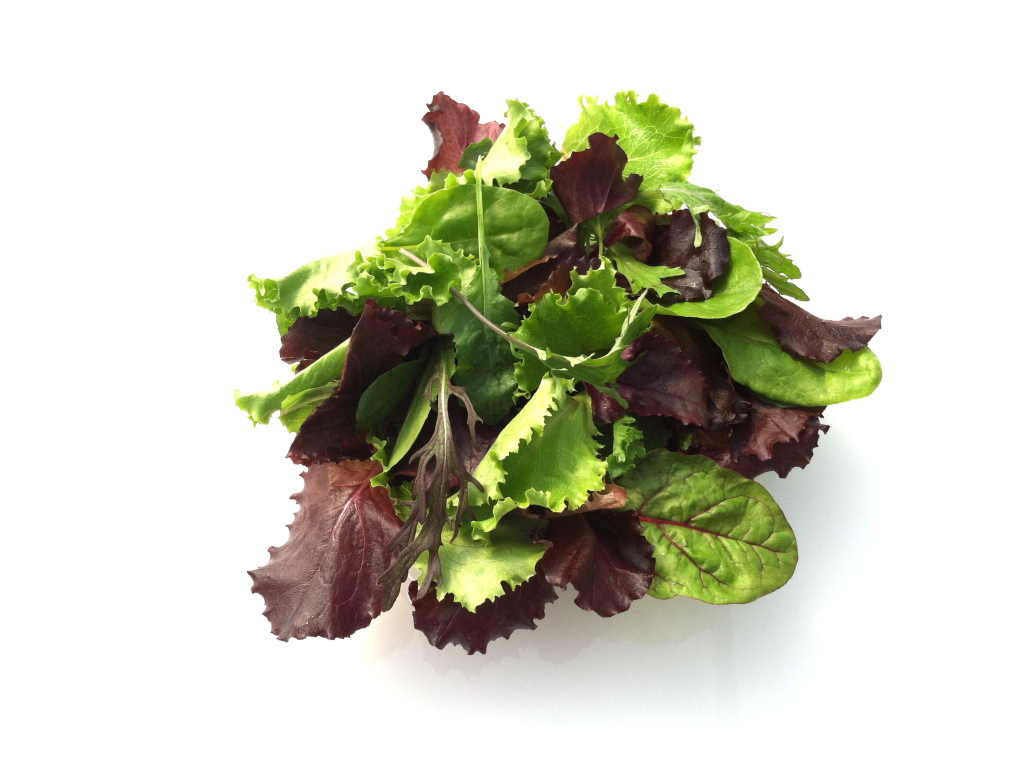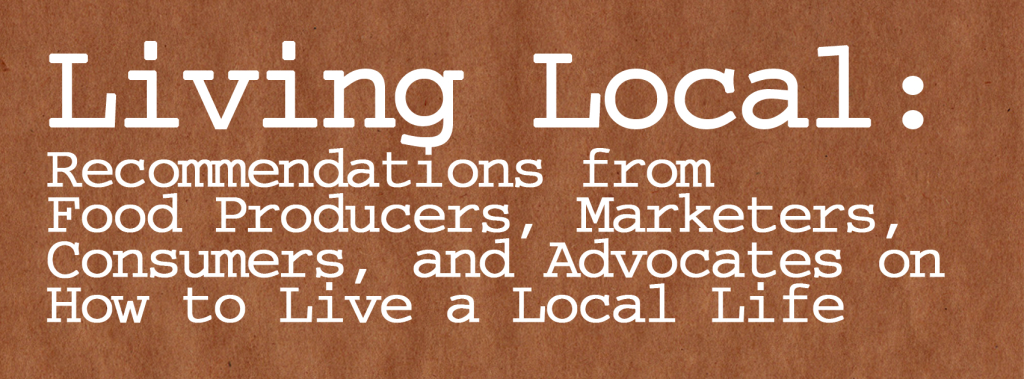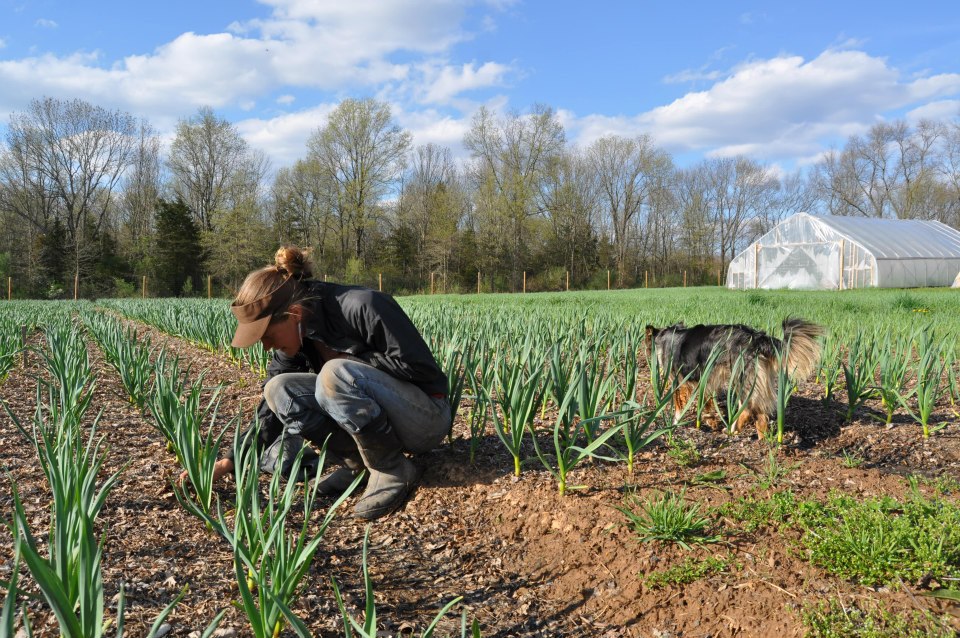Weekly: Children’s Storytime in the Garden


Let me first state that Spring Mix is just that- a mix of different lettuces and greens, not a certain type of seed or name of a plant. Some of us (*ahem. Myself*) not familiar with farming and growing things may not have known this.
Now that we’ve got that cleared up…
I hope you’ve had the opportunity to try our spring mix. If you haven’t, I hope you do soon. It is really fantastic. And I’m not just saying that because I have it for lunch every day during the season—our chefs and retail customers love it too. It is super-fresh, really tasty, and looks wonderful.
There’s a lot that goes into the delicious salad mix we produce, from sourcing to seeding and washing and storage.
We source only organic seed, which means, among other things, that it is completely GMO-free. We grow the spring mix—also called baby leaf lettuce, or just baby leaf—on raised beds.
To prepare and loosen up the soil, we till it. Once the soil is nice and pliable, we run the bed shaper over it and build our raised beds, which we seed directly into. We incorporate amendments approved for organic use to bring the soil fertility into balance. We also incorporate compost to help feed the biology in the soil. When the soil and the beds have been prepared, we are ready for seeding.
All of our baby leaf is seeded using a mechanical seeder in high-density beds.

Seeding beds
Four-to-five days after seeding, we have germination! (The miracle of Life.) All types of lettuces and various mustard greens begin popping up out of the soil. Three to five weeks later, depending on the time of year and weather conditions, the greens are at our baby leaf size. We continue to hand-weed and water throughout the growing process.

Hand-weeding a bed of lettuce
When the lettuce is the correct size, we harvest it using a mechanical harvester. We generally harvest, wash, and pack all in the same day—the day of shipment. This ensures freshness and quality. (Think about it- the salad greens are arriving in the store/at the restaurant a day or two after they have been cut!) We cut the crop only once to maintain top quality, not taking a second cutting.
We bring the different greens in from the field and blend them together- creating the spring mix. As we do this, we visually inspect for any foreign materials (compost sticks, bugs, fun things). The mix then passes through a flume-type wash system with cold water and a peroxide-based sanitizer.
The greens are all then packed, by (gloved) hand, in our dedicated clean room. From there, it is a short step to the consumer.

The finished product
 Hydroponically-grown. Soil-grown. Ever wonder what’s the difference? Hydroponic enthusiasts swear by their technology, and soil proponents swear by theirs. But which is better? Is one healthier than the other? And what about environmental impacts? Is one ‘greener’?
Hydroponically-grown. Soil-grown. Ever wonder what’s the difference? Hydroponic enthusiasts swear by their technology, and soil proponents swear by theirs. But which is better? Is one healthier than the other? And what about environmental impacts? Is one ‘greener’?
In hydroponics, water replaces soil as the medium by which plants derive nutrition. A hydroponic system can be as simple as growing in a mason jar or bucket—what’s known as ‘static solution’— or as complicated as continuously misting or ‘aerosoling’ plant roots—Aeroponics. There’s also Continuous-Flow, (water cycled continuously past the roots); Passive Sub-Irrigation, (plants grown in a porous, inert medium); and Rotary (plants rotated slowly on a circular frame to expedite root growth). In each, a nutrient solution is added to the water to ensure health and vitality.
Hydroponics boasts some tremendous advantages. An efficient system uses just 1/20th the water that traditional farming does. Nutrient levels can be precisely controlled, ensuring better yields. Additionally, hydroponics can be employed in environments where traditional agricultural practices would be impractical. And let’s be honest: growing stuff in water is just plain cool.
Still, hydroponics is far from perfect. Hydroponic systems, unlike soil, are susceptible to technical failures, leading to rapid, widespread plant death. High moisture levels can spur pathogen attacks such as damp-off. And hydroponic systems, due to their complexity, are often more energy- and resource-intensive than their traditional soil-grown counterparts. What’s more, hydroponically grown produce cannot qualify for organic certification; this is because the growing medium is inorganic.
 In traditional soil-based agriculture, plants derive nutrition via mineral deposits within the soil base; the healthier, more biologically diverse the soil, the healthier, more disease-resistant the plant. A truly sustainable, closed-circuit organic farm requires no additional inputs (supplements, aeration mechanisms, lightening systems), making it the ‘greenest’ method. And of course organic soil-farming has benefits ranging beyond watersheds and consumers: the entire biome is benefited, from the tiniest bacteria to the largest mammal. Hydroponics, always operating at a remove from the natural cycle, has a limited impact on the surrounding environment.
In traditional soil-based agriculture, plants derive nutrition via mineral deposits within the soil base; the healthier, more biologically diverse the soil, the healthier, more disease-resistant the plant. A truly sustainable, closed-circuit organic farm requires no additional inputs (supplements, aeration mechanisms, lightening systems), making it the ‘greenest’ method. And of course organic soil-farming has benefits ranging beyond watersheds and consumers: the entire biome is benefited, from the tiniest bacteria to the largest mammal. Hydroponics, always operating at a remove from the natural cycle, has a limited impact on the surrounding environment.
In terms of nutrition, hydroponic proponents claim theirs is the superior product, but so far there are no conclusive, scientific studies to back this up. While quality in either method is largely a factor of the growing medium, only soil-grown has the advantage of being more readily able to mediate excess nutrients. Hydroponics, as mentioned above, requires an additive solution; unless that solution is absolutely precise, the nutritional content can suffer. The same is not true with soil-grown.
In the end, whether hydroponic or soil-grown, what matters most is quality. A caring and discerning hydroponic farmer is sure to produce nutritious and delicious fruits and vegetables just as readily as a caring and discerning organic farmer. A win-win situation for a caring and discerning consumer!

What does it mean to live locally?
How can you be a local citizen?
Alex Jones of Fair Food Farmstand in Philadelphia suggests that getting to know your food producer–literally, the source of the food you are eating–will strengthen your civic pride.
In her words:
My suggestion would be to not only give your dollars to local businesses and food sources, but to think of food that you purchase in terms of knowing the producer, not necessarily looking for a certification on the label.
If you’re able to access food from a grower directly, or from an organization or business (such as Fair Food!) that provides transparency and information about its sources, that’s worth a lot more than buying something from a large retailer just because it has an organic label.
I also get really motivated to look for things locally because it deepens the connection I feel to my part of the world — my region, my city, my own neighborhood — and sometimes the history of that area, too.

Farmer Jess Niederer of Chickadee Creek Farm in Pennington, NJ
 For members of the Doylestown Food Co-Op, March 22nd was a special day. That was the day of their Grand Opening, the culmination of many years hard work and planning. Their first Grand Opening had been delayed by power outages caused by the February 6th ice storm, making it that much more special.
For members of the Doylestown Food Co-Op, March 22nd was a special day. That was the day of their Grand Opening, the culmination of many years hard work and planning. Their first Grand Opening had been delayed by power outages caused by the February 6th ice storm, making it that much more special.
“So many people put so much effort into our re-scheduled Grand Opening,” says the co-op’s Vice President and Product Manager, Neal Carson. “I’m sure there was some trepidation, but we were confident in our preparation. The outcome exceeded all of our expectations. It was a record-breaking day of sales for us, and 10 new members joined the co-op.”
The co-op’s roots trace back to September 2009 when residents first opened a food club to provide access to locally-raised and -produced goods. It was such a popular idea that a few short months later they started planning a bricks and mortar location. Though it was not until spring of 2013 that they had enough vested membership to make the move into their current home on 29 West State Street.
“The amount of member volunteer hours that went into starting our store is incalculable,” Neal says. “When we took occupancy in September 2013, the real work began, including the design of the store, literally hundreds of hours of demo and construction, the equipment research/purchase/installation, the product planning and establishment of accounts and delivery schedules, the staff interviews and hiring, and the procurement and setup of our POS system. I guess you could say it was hard, but I think I could speak for everyone when I say that the reward for all who contributed was well worth it.”
With over 430 members, the co-op is off to a great start. Members and non members alike can choose from an array of delicious, local purveyors: Dale’s Raw Bars, Eat This, Giggling Goat, Applegate, Castle Valley, Seven Stars, Fanciful Fox, Solebury Orchards, and, of course, Blue Moon Acres. Members enjoy daily discounts and specials, quarterly member appreciation shopping discounts, and great deals on goods and services at over 40 local shops and restaurants.
“Events like our recent Local Live concert and our August Farm-to-Table Dinner bring people together to celebrate our shared values,” Neal says. “Educational events, such as our Farm Fresh Film Series at the County Theater and our Food For Thought Book Club at the Doylestown Bookshop, help to involve and educate our greater community. We feel that we are all working together to begin a store that will influence and affect our Doylestown and Bucks County area in positive ways for many years to come.”
The Co-Op is open Tuesday through Friday from 10 to 7, Saturday 10 to 6, and Sunday 11 to 5.